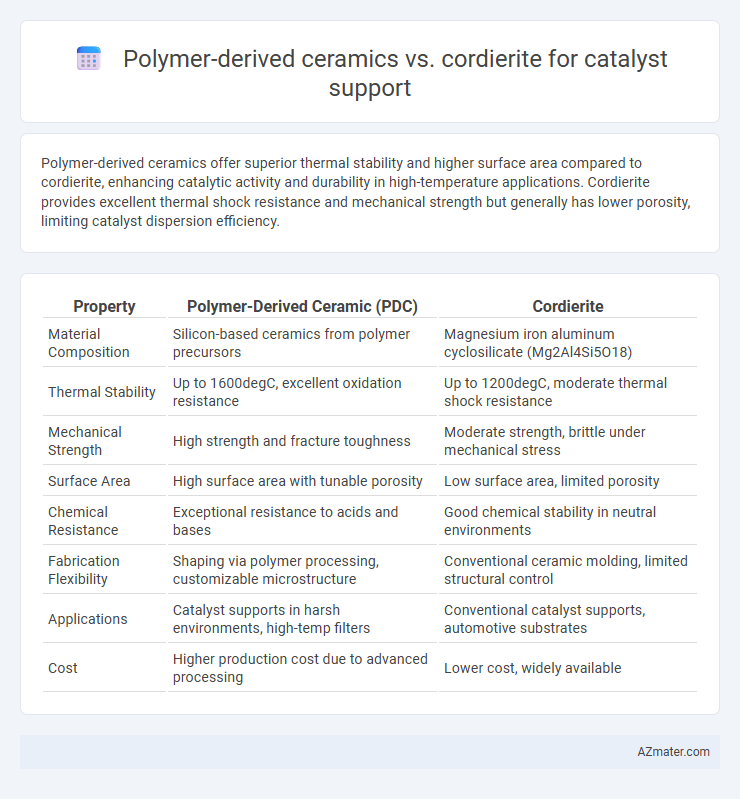Polymer-derived ceramics offer superior thermal stability and higher surface area compared to cordierite, enhancing catalytic activity and durability in high-temperature applications. Cordierite provides excellent thermal shock resistance and mechanical strength but generally has lower porosity, limiting catalyst dispersion efficiency.
Table of Comparison
| Property | Polymer-Derived Ceramic (PDC) | Cordierite |
|---|---|---|
| Material Composition | Silicon-based ceramics from polymer precursors | Magnesium iron aluminum cyclosilicate (Mg2Al4Si5O18) |
| Thermal Stability | Up to 1600degC, excellent oxidation resistance | Up to 1200degC, moderate thermal shock resistance |
| Mechanical Strength | High strength and fracture toughness | Moderate strength, brittle under mechanical stress |
| Surface Area | High surface area with tunable porosity | Low surface area, limited porosity |
| Chemical Resistance | Exceptional resistance to acids and bases | Good chemical stability in neutral environments |
| Fabrication Flexibility | Shaping via polymer processing, customizable microstructure | Conventional ceramic molding, limited structural control |
| Applications | Catalyst supports in harsh environments, high-temp filters | Conventional catalyst supports, automotive substrates |
| Cost | Higher production cost due to advanced processing | Lower cost, widely available |
Introduction to Catalyst Supports
Catalyst supports play a critical role in enhancing catalytic activity, stability, and dispersion of active materials. Polymer-derived ceramics offer superior thermal stability, structural control, and customizable porosity compared to traditional cordierite supports. Cordierite remains widely used due to its low thermal expansion and cost-effectiveness, but polymer-derived ceramics provide improved mechanical strength and resistance to thermal shock, making them ideal for high-performance catalytic applications.
Overview of Polymer-Derived Ceramics (PDCs)
Polymer-derived ceramics (PDCs) are advanced materials synthesized through the pyrolysis of preceramic polymers, resulting in non-oxide ceramics such as silicon carbide (SiC) and silicon oxycarbide (SiOC) with exceptional thermal stability and mechanical strength. These ceramics exhibit high oxidation resistance, tunable microstructures, and excellent chemical inertness, making them highly suitable for harsh catalytic environments compared to traditional cordierite substrates. The ability to engineer PDCs at the molecular level allows for enhanced porosity control and improved adhesion properties, contributing to superior catalyst support performance in automotive and industrial applications.
Understanding Cordierite as a Catalyst Support
Cordierite, a magnesium iron aluminum cyclosilicate with a low coefficient of thermal expansion, offers exceptional thermal stability and resistance to thermal shock, making it a preferred catalyst support material in automotive and industrial applications. Its porous structure enables efficient gas flow and large surface area for catalyst coatings, enhancing catalytic activity and durability under harsh operating conditions. Compared to polymer-derived ceramics, cordierite provides superior mechanical strength and long-term reliability but may have limitations in tunable microstructures and surface chemistry customization.
Material Properties: PDCs vs. Cordierite
Polymer-derived ceramics (PDCs) exhibit superior thermal stability and higher mechanical strength compared to cordierite, making them more resistant to cracking and thermal shock under harsh catalytic conditions. PDCs typically feature enhanced chemical inertness and porosity control, which improves catalyst dispersion and overall efficiency. In contrast, cordierite offers lower manufacturing costs and good thermal expansion matching with metallic substrates but falls short in durability and mechanical robustness relative to PDCs.
Thermal Stability and Performance Comparison
Polymer-derived ceramics exhibit superior thermal stability compared to cordierite, maintaining structural integrity at temperatures exceeding 1400degC, whereas cordierite typically degrades above 1200degC. The higher thermal stability of polymer-derived ceramics results in enhanced performance in catalyst support applications, providing improved resistance to thermal shock and prolonged operational life. Cordierite's lower thermal expansion coefficient offers good thermal shock resistance but limits performance in extreme high-temperature environments compared to the advanced thermal tolerance of polymer-derived ceramics.
Porosity and Surface Area Analysis
Polymer-derived ceramics (PDCs) exhibit higher porosity and surface area compared to cordierite, enhancing catalyst dispersion and reactivity. PDCs typically possess a tailored microporous structure with surface areas exceeding 100 m2/g, whereas cordierite has limited porosity and surface areas generally below 10 m2/g. This significant difference in pore volume and distribution favors PDCs for applications requiring improved mass transport and catalytic efficiency.
Chemical Resistance under Reaction Conditions
Polymer-derived ceramics exhibit superior chemical resistance under harsh reaction conditions compared to cordierite, maintaining structural integrity and catalytic performance in highly acidic or oxidative environments. Cordierite, while thermally stable, tends to suffer from hydrothermal aging and chemical attack, leading to diminished catalytic efficiency over time. The enhanced resistance of polymer-derived ceramics results from their tunable composition and dense microstructure, making them more durable in aggressive chemical atmospheres typically encountered in exhaust gas treatment.
Mechanical Strength and Durability
Polymer-derived ceramics (PDCs) exhibit superior mechanical strength and enhanced durability compared to cordierite, making them ideal for catalyst support applications subjected to high thermal and mechanical stresses. PDCs possess a high fracture toughness and thermal shock resistance due to their unique amorphous-to-crystalline microstructure transformation, outperforming cordierite's limited strength and susceptibility to cracking. This mechanical robustness ensures prolonged catalyst lifespan and optimal performance under harsh operating conditions commonly found in automotive and industrial catalytic converters.
Manufacturing and Cost Considerations
Polymer-derived ceramics (PDCs) offer enhanced manufacturing flexibility through their ability to be shaped and cured at lower temperatures compared to cordierite, enabling complex geometries and rapid prototyping. Cordierite remains a cost-effective option due to established large-scale production methods and lower raw material expenses, though its higher sintering temperatures increase energy consumption. The choice between PDCs and cordierite hinges on balancing manufacturing complexity, scalability, and total cost, with PDCs favoring advanced, tailored catalyst supports and cordierite excelling in mass-produced applications.
Application Suitability and Future Trends
Polymer-derived ceramics (PDCs) offer superior thermal stability and chemical resistance compared to cordierite, making them highly suitable for high-performance catalyst supports in automotive and industrial applications. Cordierite's low cost and excellent thermal shock resistance maintain its dominance in standard catalytic converters, but PDCs enable enhanced durability in harsh environments such as high-temperature oxidation and corrosive atmospheres. Future trends indicate growing adoption of PDC-based supports driven by advances in polymer precursor formulations and additive manufacturing, which improve microstructural control and scalability for next-generation catalytic systems.

Infographic: Polymer-derived ceramic vs Cordierite for Catalyst support
 azmater.com
azmater.com